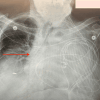Improving Outcomes Through Radiologic Verification: A Quality Improvement Approach to Nasogastric Tube Placement
- PMID: 40342435
- PMCID: PMC12060835
- DOI: 10.7759/cureus.81887
Improving Outcomes Through Radiologic Verification: A Quality Improvement Approach to Nasogastric Tube Placement
Abstract
In critical care, nasogastric (NG) tube placement is a routine procedure and is necessary for enteral feeding, medication administration, and gastric decompression. Regardless, misplacing NG tubes continues to be a common issue and can result in severe complications, such as aspiration, pneumothorax, and gastrointestinal perforation. Although chest radiographs are the gold standard imaging test to verify the placement of an NG tube, misinterpretation is still a problem, particularly for non-radiologists. Our case report is a quality improvement initiative that explores the role of radiologic verification in improving outcomes and preventing complications associated with misplaced NG tubes. We present the case of a patient whose NG tube was misplaced in his lung. We also examine the limitations of radiographic imaging as the standard method for confirming NG tube placement. We examine the potential for improving patient safety by providing radiographic training, standardizing interpretation protocols, and integrating advanced technologies such as artificial intelligence (AI)-assisted detection. Our case report explores the importance of continuous quality improvement efforts in optimizing NG tube placement accuracy and reducing associated risks, ultimately enhancing patient care and safety.
Keywords: artificial intelligence; chest radiograph; critical care; deep learning; electromagnetic guidance; nasogastric tube.
Copyright © 2025, Kumar et al.
Conflict of interest statement
Human subjects: Consent for treatment and open access publication was obtained or waived by all participants in this study. Conflicts of interest: In compliance with the ICMJE uniform disclosure form, all authors declare the following: Payment/services info: All authors have declared that no financial support was received from any organization for the submitted work. Financial relationships: All authors have declared that they have no financial relationships at present or within the previous three years with any organizations that might have an interest in the submitted work. Other relationships: All authors have declared that there are no other relationships or activities that could appear to have influenced the submitted work.
Figures
Similar articles
-
Immediate chest radiograph interpretation by radiographers improves patient safety related to nasogastric feeding tube placement in children.Pediatr Radiol. 2021 Aug;51(9):1621-1625. doi: 10.1007/s00247-021-05032-9. Epub 2021 Mar 10. Pediatr Radiol. 2021. PMID: 33688990 Free PMC article.
-
Improving the proper placement of gastric tube in the neonatal intensive care unit: A quality improvement project in China.Nurs Crit Care. 2025 Mar;30(2):e13277. doi: 10.1111/nicc.13277. Nurs Crit Care. 2025. PMID: 39989137
-
[NASO-OROGASTRIC TUBE IN PAEDIATRIC PATIENTS. REVIEW OF METHODS OF CONFIRMATION OF PLACEMENT].Rev Enferm. 2014 Sep;37(9):23-8. Rev Enferm. 2014. PMID: 26117998 Spanish.
-
Nasogastric tube placement and verification in children: review of the current literature.Nutr Clin Pract. 2014 Jun;29(3):267-76. doi: 10.1177/0884533614531456. Epub 2014 Apr 15. Nutr Clin Pract. 2014. PMID: 24737681 Review.
-
Nasogastric tube placement and verification in children: review of the current literature.Crit Care Nurse. 2014 Jun;34(3):67-78. doi: 10.4037/ccn2014606. Epub 2014 Apr 15. Crit Care Nurse. 2014. PMID: 24735587 Review.
References
-
- Use of an electromagnetic device compared with chest X-ray to confirm nasogastric feeding tube position in critical care. Bear DE, Champion A, Lei K, Smith J, Beale R, Camporota L, Barrett NA. JPEN J Parenter Enteral Nutr. 2016;40:581–586. - PubMed
-
- Accuracy of interpretation of nasogastric tube position on chest radiographs by diagnostic radiographers: a multi-case, multi-reader study. Creeden A, McFadden S, Rainey C, et al. Radiography (Lond) 2025;31:83–88. - PubMed
Publication types
LinkOut - more resources
Full Text Sources


